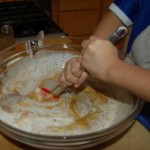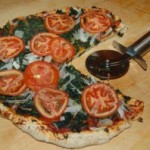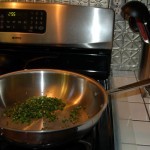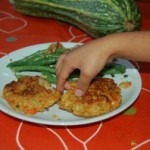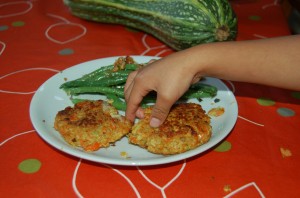
The sad state of affairs is that when I drink coffee I get reflux and nausea. Every. Single. Time. But more than that. For me, it also leads to anxiety.
This is something I see commonly with my patients and clients. Yes, even with “just” one cup in the morning. Don’t get me wrong…I’m not vilifying your coffee. There are many benefits (I’ll get into that in another post). But if you have anxiety, headaches, reflux, fatigue, or high blood pressure it might be worth seeing what life is like without coffee. After all, you can’t make an educated decision if you don’t know how you feel without it.
Here are some of the reasons that people tell me they drink coffee (and my typical counterargument for those who may do better without it.)

OK I had to put this in here. WHY WOULD ANYONE IN THEIR RIGHT MIND DO THIS?!
- It’s delicious. (So are sour gummy bears, I don’t have those every morning.)
- Without it they feel tired. (You don’t have a caffeine deficiency, something is making you tired and you should address that.)
- It gives them an extra edge/they get more done. (So would cocaine. I mean it’s not going to be laced with fentanyl, and it’s legal, and has lots of benefits but if this is why you are drinking coffee ask yourself if that is ok with you? If so…good! If not, let’s look at why and what else can give more of an edge.)
- If they don’t drink it they get headaches. (That’s withdrawal. Cutting down slowly will prevent this.)
- The term “coffee alternatives” makes them cringe.
- It’s a habit. (Is it a habit that is harmful to you? If so, there are lots of ways to break habits!)
- They need it to poop! (Sure, yes. But you should be able to poop without coffee, let’s address your digestion.)
- A family member drinks it and it’s too tempting not to when the smell is wafting through the house. (Fair…but a good enough reason? There are compromises that can be made here.)
- A hot drink in the morning is soothing, part of a morning ritual. (There are lots of lovely drinks that can be part of a morning ritual.)
And these are all reasonable. Unless they aren’t. (more…)
Read More
The first thing, before diving in, is to understand the difference between celiac disease, gluten sensitivity, and the choice to not eat gluten because it makes you feel better. Celiac disease is a genetic autoimmune disease that requires patients completely abstain from gluten, even in trace amounts. Eating gluten for these patients can have severe and long-term health repercussions. Patients without celiac disease but with a gluten sensitivity may have mild or severe symptoms when eating gluten but the gluten is less likely to do irreversible damage when it is ingested. In my opinion trace amounts of gluten should still be avoided for these folks but in most cases the repercussions are not as serious if there is a slip. People who are choosing to avoid gluten just to be healthier and feel better have the most amount of flexibility and are most often able to eat gluten intermittently without a problem. I can easily say that in the last 15 years I’ve only had a few patients that didn’t feel substantively better from avoiding gluten.
The resources that I will be offering here are mostly designed for people with celiac disease. That said, they are a great resource for anyone who wants to avoid gluten.
General Resources.
http://www.celiac.com/ General information website. Good basic information and recent news. Format of the website isn’t terribly accessible. Many ads.
http://celiac.org/ Website of the Celiac Disease Foundation.
http://www.gluten.net/ GIG- gluten intolerance group of North America. Handouts and general information for patients and clinicians alike. Information about local GIG groups.
http://www.celiacchicks.com/ Making gluten-free seem a bit more, well, cool.
Portland Resources.
http://glutenfreepdx.com/ Well written and chock full of ideas. They have a new link for gluten-free food carts…it’s not working right now but I shot the guy a email so hopefully it will be soon!
http://www.glutenfreeportland.org/ Some folks I know in Portland started this site. Fabulous for local Portland gluten-free resources as well as general information about gluten-free living.
Recipe Resources. If you love food and love cooking, one of the important things you need to do when avoiding gluten is to be able to adapt recipes to your individual needs. Also, to be able to search for recipes on line and find those that are gluten-free, even when they are not labeled or plugged as such. There are two main sites that I use for recipes: epicurious.com and cookstr.com. Neither has a great search engine for gluten-free (for instance cookstr.com has a filter for gluten-free recipes but they’ll only come up if the recipe is tagged as gluten-free.) But, there are hundreds of gluten-free recipes on this website and even more that are easily adjusted to be gluten-free. You just have to take some time to dig in. Once you find recipes you want to try you can save them to your recipe list. I go one step further and print them out to put in a binder so they’re easily accessible when I need some inspiration.
Low-carb recipes will also often be gluten-free, or easily adapted to be gluten-free.
These are a few gluten-free specific recipe sites/blogs- I haven’t tried any of them because I tend to adapt general recipes but after this post I’m excited to peruse them.
http://glutenfreegirl.blogspot.com/
http://www.livingwithout.com/ This is the companion website to a great magazine with articles about allergen-free living as well as fabulous product resources and recipes. I just signed up for their weekly recipe newsletter. If you’re gluten-free, dairy-free, or anything else-free I recommend getting the magazine.
And of course, you can find recipes right here…
Enjoy!
-Dr Samantha
Read MoreMy girlfriend Laura made this pie a while back and posted a link to the recipe on her FB page. She raved about it so I decided to give it a shot. I was surprised to see that not only is it dairy-free but also very simple to make; just my gig as I don’t particularly like to bake. Not to mention that my four-year-old really wanted to help. It turned out that this recipe is so easy I was able to let him do everything but crack the eggs. I’m patient, but not that patient.
We used a pre-made pie crust, and at the time I was still eating spelt but there is no reason you couldn’t use a gluten-free pre-made pie crust, a homemade crust, or a GF mix.
INGREDIENTS
(only slightly tweaked from the original recipe)
• One 15-oz. can organic pumpkin purée
• 1-1/4 cups unsweetened full fat coconut milk
• 3/4 cup packed light brown sugar
• 1 tsp. ground ginger
• 3/4 tsp. ground cinnamon
• 1/2 tsp. sea salt
• 1/8 tsp. nutmeg
• 4 large eggs, room temperature
• 2 Tbs. spiced rum (if you’re GF make sure to check for gluten in ingredients!)
• 1 pie crust of choice
INSTRUCTIONS
1. Preheat oven to 425 degrees and set a heavy baking sheet on the middle rack.
2. Add all ingredients to a large bowl whisk all ingredients except eggs and rum.
3. Whisk in the eggs and rum and pour into pie shell (we had a bit leftover with these shells so I filled a few ramekins too.)
4. Bake 10 minutes then reduce the oven to 350 degrees. Continue to bake until the center just barely jiggles when you nudge it. This typically takes about 45 min to an hour. The ramekins set in about 15 minutes so if you filled any, keep a close eye on them.
5. Transfer to a rack and cool completely before serving.
A few comments on this recipe. First, we didn’t have spiced rum so I used Knob Creek. I know that’s a bit of an odd substitution but it seemed to work fine. I only used half of the amount directed and next time will plan to use spiced rum per the original recipe. Also, a quick note on brown sugar. Apparently it is difficult to source brown sugar that is ethically produced. Our local co-op didn’t even carry it. I was, however, able to find a fair-trade golden brown unrefined mascobado sugar from Alter Eco Fair Trade at New Seasons (our local health food store.)
Please note I am well aware that this pie doesn’t look very good (ahem, understatement). We’re going to try to top it with a vegan whipped cream so no one will know. I’m not particularly optimistic but I’ll keep you posted.
Read MoreThis gluten free bread mix was recommended to me a few years ago. It turns out that this mix is based on a traditional Brazilian cheese bread called Pão de queijo. Similar breads are also found in Bolivia, Paragua, Argentina and Colombia. They can be made from scratch or more commonly from a mix. The main ingredient is usually Cassava or Tapioca flour, and in Colombia is also typically made with corn meal. The traditional recipe includes cheese but with Chebe mix the cheese is optional. It also calls for adding eggs, milk, and oil. We use almond milk in place of the cow milk and it works just fine (I think you could use any milk substitute for that matter.) There are several different Chebe mixes available: pizza crust, rolls, sandwich buns, bread sticks, and cinnamon rolls. I’ve seen them in PDX at New Seasons and at Fred Meyers.
We tried the pizza crust this week and it was great. The cool thing about this product is that it has that chewiness of pizza crust that typically gluten free crust just doesn’t have. My 4 year old doesn’t eat wheat but he does eat gluten so we used to get Graindance spelt pizza crust before our local health food store stopped carrying them. The problem is that now he doesn’t know that pizza should be chewy so sadly, he didn’t like the Chebe. Bummer for him but great for the grownups, we got to eat it all and enjoyed every bite.
As for toppings, you could use anything you’d want to put on pizza.We’re dairy-free at our house so we made the pizza without cheese then sprinkled Daiya shreds on top. That review will be next week.
Enjoy!
-Dr Samantha
Read More
The fabulous thing about this magazine (and show) is that they try technique after technique to come up with the easiest and tastiest way to cook any dish, or type of dish that they’re discussing. They then present not only the ‘how-to’ but also the ‘how-not-to.’ This is particularly good for me because I have a tendency to try to cut corners if I think I can get away with it. Although I’m not sure how the February Cook’s Illustrated ended up on the top of my magazine pile this week, I was excited to find a recipe for Thai chicken that didn’t contain soy, or so I thought. Turns out (of course) that oyster sauce has soy in it. As I had already purchased everything for the recipe I went ahead and made the dish replacing the oyster sauce with coconut aminos. Not the same by any stretch of the imagination but the final result was authentic tasting and delicious. Good enough for me.
I was about to link to the recipe with discussion but it’s subscription only so I’ll post what I did, which is of course, different than the actual recipe (I’m like that). The subscription is $35/year and would be worth it if you’re looking to gain some basic cooking skill or hone basic cooking skills. You can get a 24 hour free pass to the website so if you want to read the actual recipe or the details about why they use certain techniques.
Ingredients
- 2 cups fresh basil tightly packed
- 4 cloves of garlic
- 1 medium jalapeño pepper
- 2 TBSP thai fish sauce (Thai kitchen brand has one with no additives, etc.)
- 1 T coconut aminos
- 2 tsp white vinegar
- 2 tsp raw sugar or agave
- 1.25 lb free range or organic chicken thigh meat cut into 2-3 inch pieces
- 5 large shallots
- 2 TBSP high heat stable oil
Directions
- Put 1 cup of the basil leaves, the garlic and the chiles in the food processor. Pulse until finely chopped, scraping down if needed.
- Take out 1 T of the mixture, place in small bowl, and stir in 1 T fish sauce, liquid aminos, vinegar, and sugar, set aside. Put the rest of the mixture in a large skillet or sauté pan.
- Without cleaning food processor, add the meat and the rest of the fish sauce and pulse until it is in small pieces, about 1/4″. Put this in the refrigerator until you’re done with step 4.
- Add oil and shallots to mixture in pan. Cook over medium-low heat, stirring regularly until the shallots are starting to turn light golden brown. Cooking slowly here, according to the cookbook author, is imperative. The recipe called for 5-8 minutes but it took about 12 minutes on my stove before they started turning color. The smell in the kitchen at this point should be making your mouth water.
- Add the chicken, turn up to medium heat and cook until the chicken is just translucent. Now add the sauce you put aside in step 2.
- Continue to stir until the chicken is cooked then add the rest of the basil until it wilts into the dish. WAIT on this step if you are cooking for another day (I think this dish would be ideally served hot off of the burner but on our menu this week it’s Tuesday’s dinner…)
The original recipe calls for serving the dish with extra fish sauce, sugar, red pepper flakes and vinegar in separate side dishes so people can adjust to their own taste. I’m pretty sure I won’t bother with all that…but I will put a bottle of vinegar and some hot pepper flakes on the table.
At this point my plan will be to serve it over black or brown rice with sauteéd broccoli and garlic. I bet it would also be good wrapped in rice paper and dipped in more of the sauce. I’ll try that next time.
Enjoy!
-Dr Samantha
Read MoreI had some leftover salmon in the fridge and spent some time perusing my usual recipe haunts such as cookstr and epicurious for a salmon cake recipe to try. I made one and they fell apart (unfortunately trashed the link) and none of the other salmon cake recipes I found both fit my dietary requirements and looked remotely edible. Then I came upon a recipe for curried quinoa salmon cakes at The Whole Life Nutrition Kitchen blog. I typically really like the recipes (they tend to be pretty hard core health food) on this website but these also fell apart. Then I found some random guy’s recipe blog, made a few changes and ended up with a delicious winner!
Mix:
• 2 cups cooked salmon, flaked. Avoid farmed salmon if you can.
• 1 cup cooked Quinoa
• 1 teaspoon curry
• 1/3 cup shredded coconut
• 1/2 stalk celery, finely chopped
• 1/2 leek cleaned and finely chopped
• 1 egg plus one egg white
• 1/4 cup mayonnaise, more if needed to hold ingredients together when you grab a handful and squeeze
• 2-3 TBSP fresh chopped parsley or basil if desired
Make into patties and pan fry. I used olive oil but if you’re going to heat to smoke point which would probably work best…I might suggest grape seed oil or actually, coconut oil since this dish already has coconut in it. Yes, that’s what’ I’ll use next time, coconut oil. And please, don’t be stingy with the oil.
I served these with cumin aioli.
• 1/3 cup mayo. We use canola mayo because so many others have soy oil in them, and I’m not a fan.
• 1/2 tsp dijon mustard
• 1/4 tsp finely chopped or pressed fresh garlic
• 1-2 tsp ground cumin. If you have the wherewithal lightly roast fresh seeds on the stovetop then grind in a spice grinder or with a mortar and pestle.
• High quality olive oil to preferred texture. I like my aioli a little more runny when I put it on top of fish cakes.
We served this up with lemon walnut green beans. I’ll post that recipe soon. The kid loved it all. We did too.
Read More
Add more energy to your life every day.
Get 7 days of energy-infusing practices delivered to your inbox, FREE!


